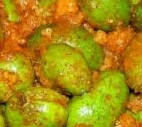 Summer means many things to many people. To some, it is vacation. To some, travel. Others warmth. Heat, humidity, cousins visit, festivals, story books....
Summer means many things to many people. To some, it is vacation. To some, travel. Others warmth. Heat, humidity, cousins visit, festivals, story books....But if you were born and bred in the South of India, summer is synonymous to Mango. Every house (rapidly being replaced by multistorey apartment complexes with names such as "Green grove" with not a single potted shrub in sight) in Tamil Nadu, would necessarily have three trees in its courtyard - neem, coconut and mango. Any festival at home is marked by a garland of mango leaves at the main door.
 |
| Source |
Maavadu pickle making was an art. First, the small mangoes would be washed with water, and dried overnight on spotless white "Malayala thundu" or the husband's dhothi. Then, the women of the house will smear their palms with castor oil and stir the maavadus in a big bronze "Andaa". Once each mango has been coated by a thin layer of castor oil, they will be transferred to a stone or porcelain "jaadi" and rock salt will be added to it. A day after, spices will be ground and added to this. The mix will be gently shaken, not stirred every morning after a bath (no touching pickle container without bath). The mouth of the container would be sealed using a cloth and left to marinate over days. A small amount will be transferred every morning into a cup for the day's use.
After playing roadside cricket, or paandi or cycling in the hot kathri sun all morning, the kids of the house would be summoned by the grand mom who would make them sit around her, with a small cup of the maavadu each. She would mix curd rice in a large bowl and place a ball of it on each child's palm. A bite of the mango with this ball of curd rice, on the cool red-oxide floor, grandmom's stories and cousins comapny..mmm...
| Source |
May would start the housefly season. Along with it, the ripe mango (mambazam) would arrive. Salem mambazam, Srirangam's famous Imam Pasand, Mayavaram's Padhiri, Bangalore Banganapalli, Rumani, etc. etc...a staggering variety. No meal would be complete without a dessert of mangoes. Some would even eat curd rice with mambazam (ahem) and gross out family members who are sticklers for pure tastes. Mango payasam, mango juice, mango "crush", mango ice cream...mango would reign supreme.
So would diarrhea, but who cares. The mango season would soon pass, and no point not plunging headlong into it.
Mango is a tropical tree, and is native to South East Asia, mostly India, Malaysia and Thailand. The word "Mango" and the scientific name "Mangiferra" are derived from the Tamil word "Mangai". The greatest nutrient value of Mango is its fiber content (see earlier reference to diarrhea), vitamin C and Vitamin A. Scientific studies have also shown that mangoes can protect against prostrate and skin cancer [1] and have antioxidant properties [2].
As with everything else, with over-indulgence comes disease. The high fiber content can lead to gastrointestinal problems. The fruit can spike up your sugar levels, and being laden with calories, can tip the scales into levels you'd like to ignore. Some people (not Indians, we were all dropped into a mango cauldron as kids) have allergic reactions, and the sap from the tree can cause skin lesions and diseases.
Rightly has mango been called the queen of fruits, and the National fruit of our country.
[1] Chaturvedi PK, Bhui K, Shukla Y (2008). "Lupeol: connotations for chemoprevention". Cancer Lett 263 (1): 1–13.
[2] Rodeiro I, Cancino L, González JE, et al. (2006). "Evaluation of the genotoxic potential of Mangifera indica L. extract (Vimang), a new natural product with antioxidant activity". Food Chem Toxicol 44 (10): 1707–13.


Oh that mavadu looks so appetising... I wish I could have some... sigh!!! Lovely post, Lakshmi!
ReplyDelete